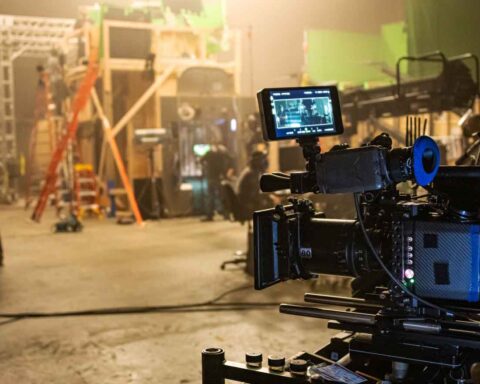Scanners are indispensable in creating and filing digital copies of the documents we use in production. So, if you’re going to acquire a printer, you might as well go for one that makes your job easier and faster. To be clear, I not a shill for any equipment manufacturers, I’m just a guy who needs to scan a bunch of shit and this is how I do it.
The Scanners that we use is the Snapscan S1500. Different versions of these scanners are released into the market every year and they have desktop and portable versions and this is the version we use in 2018.
The desktop version is fast. It scans both sides of a document in one pass and it is equipped with several other features that simplify the scanning and filing process. It also comes with the software that is required to save these files into whatever computer you’re using. The desktop version is not small. It’s about the size of one of the larger Sonos speakers or for a reference we can all see – 4 of them can fit into a banker’s box. It just sits on your desk and connects to the computer you are using. You can look up its exact dimensions online.
There is a smaller (portable) version that is about 11 inches wide, 5 or 6 inches deep and not very call at all (like 5 inches). It’s something you can shove in your bag and have on location. It scans very well and you can sheet feed a single piece of paper into it one at a time.
Some portable versions of Snapscan scanners are rechargeable but the desktop versions plug into the wall. Some offer wireless connectivity and others need to be plugged into your computer so it can then talk to your computer.
Once the device is connected, you install the software that comes with the scanner. The software that comes with it allows you to store the scans into a PDF and many other image file format. We store and scan everything in PDF because PDF files are everywhere and the software to read them is free. It is an open source software now, so anybody can read them and they are compatible with everything.
PDF files have cross-platform compatibility; they transfer and transition across platforms really well. Apple users can read them, PC users can read them, the Linux users can read them, and they are also accessible on Android devices.
Snapscan scanners get the job done but they are not the cheapest things out there. We’ve had many of them in our office and we just keep buying them because they’re great and they work – and work for years before having to replace them. Their price range is around $180 to $300 for the smaller ones, and the larger ones costs anywhere from $400 to $700. They are made by Fujitsu and you can get them online or from staples.
If you’re not looking at a Snapscan scanner, in other words, if you are considering getting another brand, make sure the scanner has these features:
#1. The ability to scan two sides of a paper in one pass.
There are a few HP scanners in offices that do two-sided scanning by using a single scanning bar at the top of a multifunction printer where it sucks the paper in, scans it, spits it back out the top, then sucks it back in and scans the back, then sucks it back in and reverses the page for output – that’s fucking idiotic. In that process of spiting it out and sucking it back in, it’s scanning the front and scanning the back, but you have to pass that piece of paper through the scanner twice.
Ensure the scanner you’re getting is able to do a two-sided scan in one pass. Snapscan scanners have this feature, and again, I don’t derive any benefit from Snapscan, I just happen to love how it works.
Some scanners will say they’re two sided, but they do that by sucking the paper in, and spitting it out, and sucking it in again to scan the other side. Then it has to suck it back in one more time to write the paper back up so that it comes out in the same order that you put it inside the feeder, which is a waste of time.
#2. Blank document removal
Another thing that is helpful but not required is blank document removal. Get a scanner that is able to detect blank pages so that, if you scan the front and back sides of every piece of paper, the scanner can automatically remove the backside of those pieces of paper that are blank.
That way, it won’t store nothing. This is helpful because it reduces the file sizes. Not that it really matters because we’re talking about megabytes, not gigabytes of storage, but everything helps when we’re talking about scanning.
#3. Speed is Important
Another thing to look out for is how fast does the scanner go? The faster the scanner, the better. Every year, they seem to get faster and faster.
#4. Landscape Auto-turn
The other thing we like, which isn’t actually a necessity is the landscape auto-turns. If you feed a set of documents into the scanner and some of those documents have portrait orientation while others have landscape orientation, the ones with landscape orientation will be turned on their sides because they have to go in the same way that the portrait papers do.
Most scanners or most good scanning software, will automatically flip the papers with landscape orientation 90 degrees so that they now line up and they’re turned in landscape orientation.
Get scanners and scanning software that have this feature and you won’t have to turn your head to read a document on the screen or manually rotate them before reading. That’s a key benefit to whatever software you buy, it’ll save you tons of time.
#5. Optical Character Recognition (OCR)
We love to see this feature in our scanners. You should have it in whatever scanner you decide to go with. If you OCR everything when they come in, you can strip the text layer off of those files and store the metadata inside a separate tag so that if you need to search for something, you can search through everything. It allows most software that store digital paper (Windows 10 inclusive) to look inside the text layer of a PDF when you run a search on a file or a group of files. So OCR is really helpful.
Its performance depends on the size, type of operating system, and the processing power of the computer that the scanner is attached to. OCR is a memory pig. It does take some memory to get it to function, but it’s super helpful. So, if you can have it and the machine, you’ve attached the scanner to is one that can do the OCR quickly without slowing you down, turn it on and let it collect the data. It only takes bits and that’s not a lot of data being stored, so I would use it.
#6. Set Your Scanner Resolution to 150 or 300 DPI
Finally, your scanner should be set to a resolution of 150 or 300 DPI. Outputting color is helpful, although not required. If you’re not going to scan in color, scan in black and white; it will make the file sizes really small. If you have a huge file that maybe has a hundred or more pages in it, I’ll typically scan those at 150 DPI screen resolution in black and white only, and those files will not be huge. Believe it or not, some PDFs with about 50 or 60 pages, scanned in black and white, at 150 or 300 DPI will store at under a megabyte or sometimes, just over a megabyte, especially if it’s just text and not images.
So whatever scanner you buy, you want to have a couple of things in it:
- You want it to scan two-sided in one pass.
- You would like to have blank document removal.
- OCR
- Landscape auto turn, and;
- It has to be fast.
These are the sort of key important points to make sure that your machines have.The scanner you’re using or the one you buy must have the software that connects it to a computer.I’m not a fan, through my experience, of standalone HP scanner-printer or multifunction devices. They are okay (read Fuck HP), but they’re expensive and they don’t actually work well.It’s better to have a standalone thing that you can stick inside a briefcase, banker’s box, suitcase or whatever and bring with you wherever you go.








